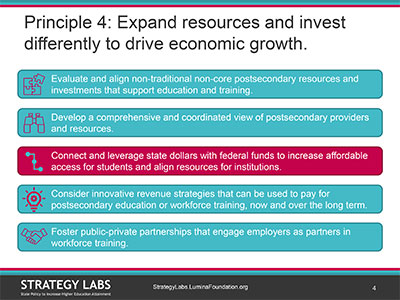Challenges and Opportunities: How Can Higher Ed Help our States Rebound from COVID-19?
The pandemic revealed the capacity of higher education to adapt to dramatically changing circumstances. Fueled by one-time federal and state assistance, colleges and universities are making strategic changes and investments for a more sustainable future.
MHEC, in partnership with Lumina Foundation’s Strategy Labs, hosted three virtual webinars over the past few months to explore how higher education can play a role in helping our economies rebound from COVID. The series built on a November 2020 report from the Lumina Foundation and Bill & Melinda Gates Foundation, “Higher Ed Finance in the Post-COVID Era.”
The February webinar featured an interactive discussion with two national leaders in higher education finance — Martha Snyder, HCM Strategists, and Donnie Charleston, E Pluribus Unum — along with a panel of regional leaders – Rep. Rick Carfagna (OH), Blake Flanders (KS), Rep. La Shawn Ford (IL), Dr. Kayla Hahn (MO), and Bill Pink (MI).
In response to this initial webinar, MHEC hosted webinars in April to address two key questions related to the report: How can states best navigate the interrelated conditions of COVID-19 and the historical and structural roots of inequities within higher education? How can states target postsecondary investments effectively to ensure more sustained and equitable recovery?
Investing to Drive Economic Growth
Elizabeth Salinas from HCM Strategists discussed how states were making strategic decisions about higher education investment with the federal relief. For example, North Carolina invested federal dollars in its community college system to provide tuition assistance  for students enrolled in short-term workforce training programs in high-demand fields and Rhode Island launched Back to Work RI, a public-private partnership to train, support, and hire residents displaced by COVID-19.
for students enrolled in short-term workforce training programs in high-demand fields and Rhode Island launched Back to Work RI, a public-private partnership to train, support, and hire residents displaced by COVID-19.
MHEC Commissioner Teresa Lubbers, who serves as Indiana’s Commissioner for Higher Education, shared details of her state’s new program to help people affected by the pandemic more easily secure education, training, and career coaching to find a quality job. Lubbers reported that 44,000 people had already enrolled in the program, which she says meets the needs of employers, improves economic mobility for individuals, and improves the state’s economic outlook.
Peter Blake from the State Council for Higher Education in Virginia shared details about his state’s free community college program and specifically its intentional focus on equity.
Advancing Credential Completion
The second follow-up webinar in the series explored support programs and strategies that advance students’ ability to complete credentials and featured MHEC Commissioner Jack Hershey, president of the Ohio Association of Community Colleges, and Mario Carrera, trustee of Metropolitan State University in Denver.
The webinar included examples of programs that align and target resources to support getting students into and through credential programs as quickly as possible. Specially noted was City University of New York’s program to integrate wrap-around services into a structured associate degree pathway. The program is reporting a three-year graduation rate of 52%, more than double the previous 24.6%.
Hershey said that despite challenging times for community colleges, almost everybody is optimistic about short-term, credential-based training programs. He has found widespread, bipartisan support for these programs, which have a quick turnaround and get people back into the workforce rapidly.
Carrera pointed out that credentialing can be a response to both addressing inequities and meeting employer demands.
In the coming months, MHEC will continue to explore how higher education is and playing a key role in states’ economic recovery from the pandemic.